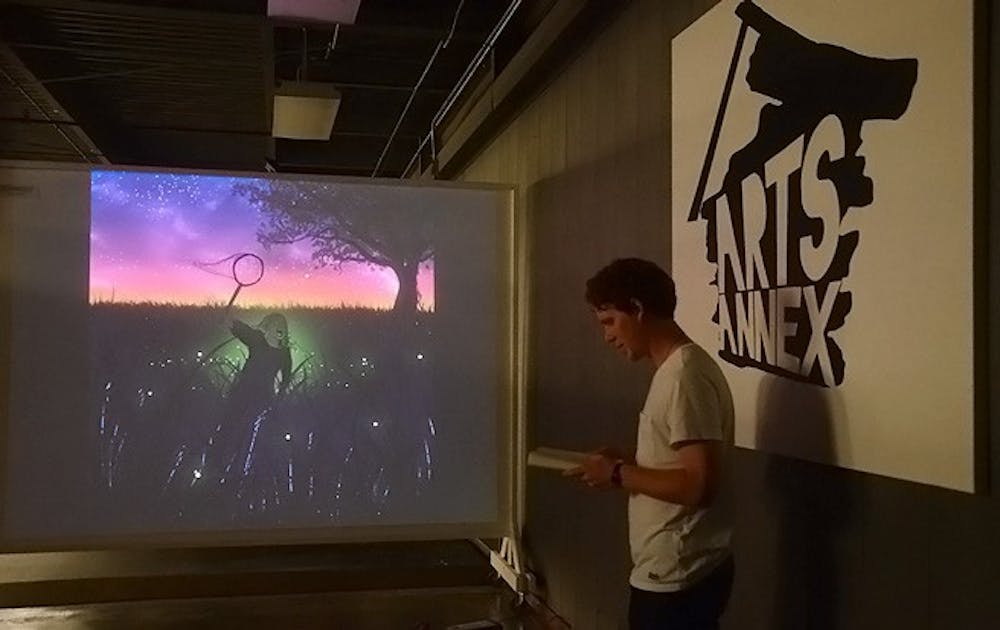My first climb up the Arts Annex walkway was dark, uninviting and completely misleading. At 6:30 p.m. on Tuesday, the path towards the back entrance of the Annex was forebodingly quiet. The chainlink keycard gate seemed like the entrance to a military compound. The only evidence of student activity was a series of finished canvases hanging on a cable between the trees; but even then, with only lamplight to illuminate the works, the mini-gallery had a multicolored glow that suggested the presence of some secret art cult.
That is, the relative warmth of the Annex interior was totally surprising. As soon as I swiped in, my impressions of Duke’s new arts collective were dismantled. Student art covered the walls and overflowed on the floor. A mingling of MFA students collected on several couches, which angled toward a screen to create an impromptu theater. And yes, they had pizza and drinks. I was proven wrong. The renovated warehouse wasn’t some inaccessible, privately commandeered hideaway for esotericism after all. It immediately struck me as the lively public workshop it’s been rumored to be.
The event I attended that evening, an hour of multimedia presentations advertised as a “Pecha Kucha Night” (PKN), only confirmed my newfound positive impression of the space. The new monthly discussion series, open to the entire Duke community, encapsulates the Annex’s nascent identity as an interdisciplinary hotspot for Duke artists of all mediums. Furthermore, the gathering epitomizes a casual salon-culture that Duke could always use more of.
Now, when I say “multimedia presentations,” I’m being vague. Still, I’m not sure how to avoid a broad description: PKN showcased such a diverse set of pieces that it’s tough to give the event a single identity. In this way, PKN again embodied the flexible and accommodating personality of the Annex.
The event name inspires a specific presentation format, which forms the rough foundation for Duke’s gathering. “Pecha Kucha,” which is Japanese for “chit-chat,” was first coordinated in Tokyo in 2003 as an open forum for designers and artists to present their work to other professionals. Since then, the event style has gone viral across the world, with regular gatherings organized in over 500 cities. Typically, the presenter shows twenty pictures and gets twenty seconds to talk about each one. With only six minutes and forty seconds, presenters are forced to be concise.
Since the first Duke PKN last month, presenters have showcased videos, multimedia installations, or snippets of photography portfolios. I saw six presentations, which employed a range of visual media to discuss distinct topics. On the one hand, Ph.D student Pinar Yoldas presented her installation, “Scream! a homage to Edward Munch,” which used animatronic skulls to embody the plight of endangered species. Runa A, an MFA student in Duke’s Experimental and Documentary Arts program, set an entirely different tone with the only physical installation, which involved video projection onto a large paper mask. She says she reformatted a previous live-action installation into a video just for PKN, one which involved her blindly cutting newspaper bandages that covered her head.
The focus even turned from experimentalism to global documentary studies. Jason Woerner, a graduate student in the Cultural Anthropology department, presented a selection of photos from his multinational portfolio on the ripples left by Soviet expansion across Asia, “Chasing the Ghost of Karl Marx.” Because his study spanned several cities and countries, he contained his PKN slideshow to a few shots of Mongolian development.
John Rash, the event organizer, says the versatility of the space added to PKN’s atmosphere. “The Arts Annex is a great venue, because it’s not like you’re in an auditorium or a lecture hall,” Rash said. “It’s more like you’re in someone’s living room.”
Rash says his PKN is inspired by, but deviates from, the pilot format. While he still hopes to emphasize the 6:40 time limit, future PKN will allow for submissions of all types.
“We’d like to make it more inclusive to all the arts,” explained Rash. “Ideally there should be a visual element, but I’d like to see films or musical or dance performances.”
Woerner, who had just returned from a seven-year study abroad, was initially skeptical of the “Pecha Kucha” structure, but commented on the success of the night as a whole. “I really liked seeing people from a variety of disciplines coming together and make their work fit the 20x20 format,” Woerner noted. “What starts as a restriction becomes a unifying factor.”
The event was run mostly by graduate students, but Rash emphasizes that PKN invites submissions from anyone in the Duke and Durham community.
Rash started the night off, in fact, with a short documentary of his own, which he arranged using both “found” and “borrowed” footage. I definitely didn’t expect to begin a night of intellectualism with the “woawp, woawp” of PSY’s “Gangnam Style,” but Rash set the Korean pop hit against clips of police brutality—specificially towards the Occupy protests—to create an eerie irony. He noted that though the music and visuals seem unconnected, they fit together because he’s “seen too much of both.”
Rash’s final product, as well as all the PKN presentations, was a refreshing, unique glimpse into Duke’s visual media subculture. I suppose “sub”-culture is no longer the right word; events like Pecha Kucha, which has its third installment January 22, will hopefully broadcast the visual-media life here at Duke and generate the student attention it deserves.
Get The Chronicle straight to your inbox
Signup for our weekly newsletter. Cancel at any time.

